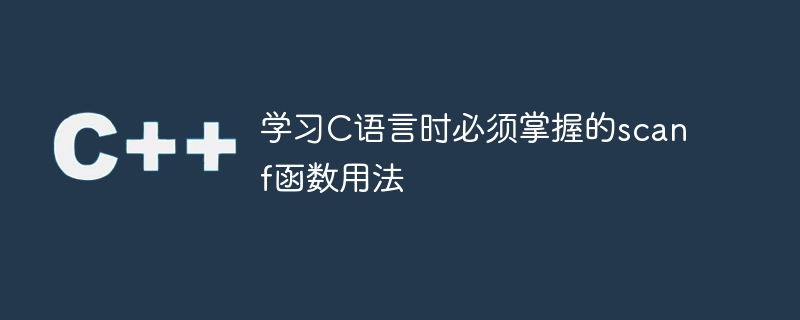

The usage of the scanf function that must be mastered when learning C language requires specific code examples
C language is an advanced programming widely used in system programming and application software development language. In the process of learning C language, it is very important to understand and master the use of scanf function. The scanf function is a function in C language used to receive input data from the standard input stream (usually the keyboard). This article will introduce the basic usage of the scanf function and provide some specific code examples to help readers better understand.
First, let us understand the syntax of the scanf function. The prototype of the scanf function is as follows:
int scanf(const char* format, ...);
The first parameter of the scanf function is a string constant, used to specify the input data Format. This string can contain several format indicators, each format indicator corresponding to a variable in the input data. Format designators include %d (integer), %f (floating point), %c (character), and so on. When reading input data, the scanf function will read in the order of format indicators and store the read data in the corresponding variables.
The following is a simple sample code that demonstrates how to use the scanf function to read an integer and output it:
#include <stdio.h>
int main() {
int num;
printf("请输入一个整数:");
scanf("%d", &num);
printf("您输入的整数是:%d
", num);
return 0;
}In the above code, we use %d as the format indicator, indicating Accepts an integer input. When calling the scanf function, we pass the address of the variable num as a parameter to the scanf function so that the input integer is stored in the variable. Finally, the input integer is output through the printf function.
In addition to reading integers, the scanf function can also read other types of data. For example, we can use %f to read floating point numbers, %c to read characters, and so on. The following is a sample code for reading floating point numbers:
#include <stdio.h>
int main() {
float num;
printf("请输入一个浮点数:");
scanf("%f", &num);
printf("您输入的浮点数是:%f
", num);
return 0;
}In the above code, we use %f as the format indicator to indicate receiving a floating point number input. Similar to the code for reading integers, we pass the address of the variable num to the scanf function and output the input floating point number through the printf function.
In addition to basic data types, the scanf function can also be used to read strings. We can use %s as the format indicator to read the string as follows:
#include <stdio.h>
int main() {
char name[50];
printf("请输入您的姓名:");
scanf("%s", name);
printf("您的姓名是:%s
", name);
return 0;
}In the above code, we define a character array name of length 50 to store the input string. Use %s as the format indicator to receive a string input. When reading a string, the scanf function automatically stops reading at whitespace characters (such as spaces and tabs) and stores the read string in the name array.
In addition to reading data, the scanf function can also be used to determine the validity of the input. For example, we can use the scanf function in combination with a loop to read multiple integers and calculate their sum until the input integer is 0. The following is a sample code:
#include <stdio.h>
int main() {
int num, sum = 0;
printf("请输入多个整数(以0作为结束标志):");
while (1) {
scanf("%d", &num);
if (num == 0) {
break;
}
sum += num;
}
printf("这些整数的和是:%d
", sum);
return 0;
}In the above code, we first define an integer variable num and an integer variable sum, which are used to store the input integers and their cumulative sum. Through an infinite loop, we repeatedly call the scanf function to read integers. When the input integer is 0, the loop terminates. Finally, the accumulated sum is output through the printf function.
To sum up, the scanf function is a very important function in C language. It is the main way to read input data from the standard input stream. By understanding and mastering the usage of the scanf function, we can process user input more flexibly, thereby developing more practical and easy-to-use C language applications. I hope the code examples in this article can help readers better understand and apply the scanf function.
The above is the detailed content of Master the use of scanf function, which is essential in C language learning. For more information, please follow other related articles on the PHP Chinese website!




